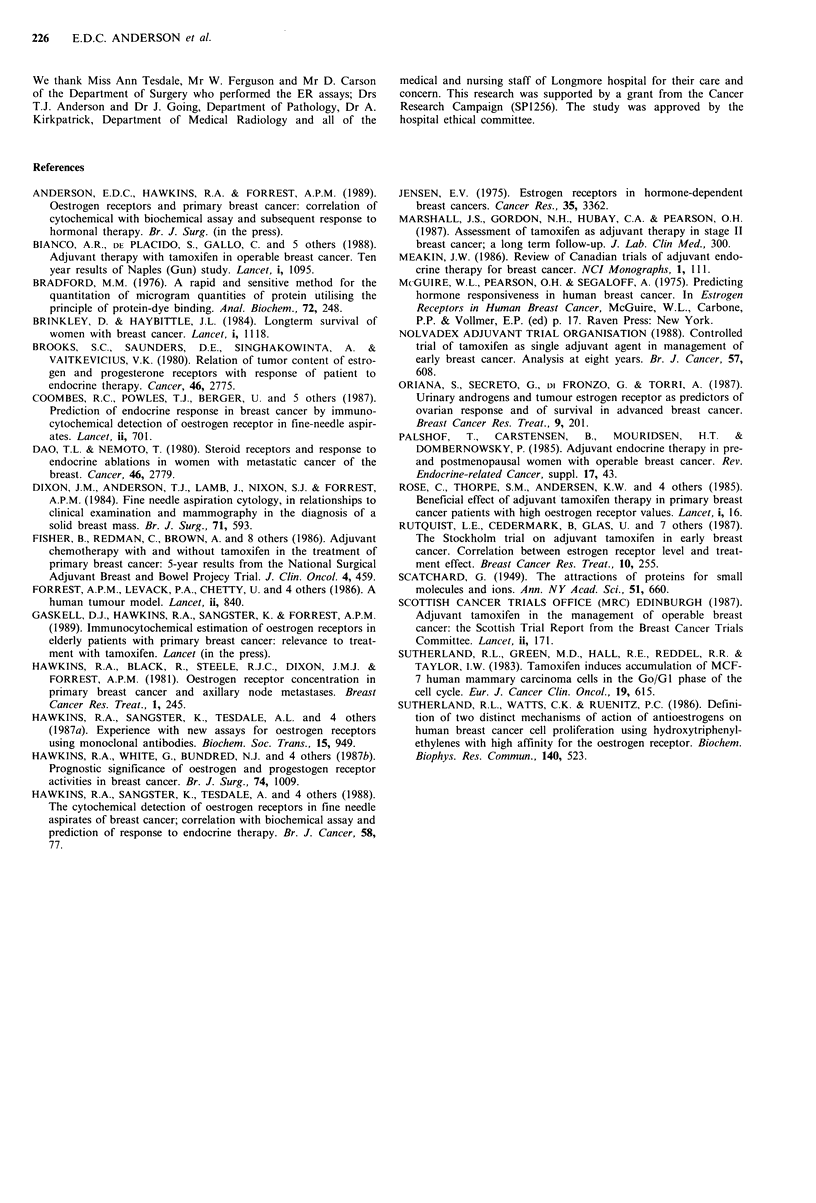Abstract
Forty-three patients with large (greater than or equal to 4 cm) but operable carcinoma of the breast have been treated by endocrine manipulation before definitive local surgery. This has allowed the study of the relationship between response to therapy and pretreatment oestrogen receptor (ER) concentration, as measured by a dextran-coated charcoal adsorption method. Premenopausal patients (17) were treated by surgical (4) or medical (13) oophorectomy. Post-menopausal patients (26) received either tamoxifen (10) or an aromatase inhibitor (16). Response was assessed from statistical analysis of the changes in tumour size. On completion of 12 weeks of endocrine therapy, there was significant regression of tumour size in 18 of the 43 patients. All 18 patients had tumours with ER concentrations of greater than or equal to 20 fmol mg-1 cytosol protein. Conversely all patients except one progressing on treatment had tumours with ER concentrations of less than 20 fmol mg-1 cytosol protein. This relationship applied for both premenopausal and post-menopausal patients. The overall response rate of patients with tumours of ER concentration greater than or equal to 20 fmol mg-1 cytosol protein was 60%.
Full text
PDF



Selected References
These references are in PubMed. This may not be the complete list of references from this article.
- Bianco A. R., De Placido S., Gallo C., Pagliarulo C., Marinelli A., Petrella G., D'Istria M., Delrio G. Adjuvant therapy with tamoxifen in operable breast cancer. 10 year results of the Naples (GUN) study. Lancet. 1988 Nov 12;2(8620):1095–1099. [PubMed] [Google Scholar]
- Bradford M. M. A rapid and sensitive method for the quantitation of microgram quantities of protein utilizing the principle of protein-dye binding. Anal Biochem. 1976 May 7;72:248–254. doi: 10.1006/abio.1976.9999. [DOI] [PubMed] [Google Scholar]
- Brinkley D., Haybittle J. L. Long-term survival of women with breast cancer. Lancet. 1984 May 19;1(8386):1118–1118. doi: 10.1016/s0140-6736(84)92525-x. [DOI] [PubMed] [Google Scholar]
- Brooks S. C., Saunders D. E., Singhakowinta A., Vaitkevicius V. K. Relation of tumor content of estrogen and progesterone receptors with response of patient to endocrine therapy. Cancer. 1980 Dec 15;46(12 Suppl):2775–2778. doi: 10.1002/1097-0142(19801215)46:12+<2775::aid-cncr2820461406>3.0.co;2-5. [DOI] [PubMed] [Google Scholar]
- Coombes R. C., Powles T. J., Berger U., Wilson P., McClelland R. A., Gazet J. C., Trott P. A., Ford H. T. Prediction of endocrine response in breast cancer by immunocytochemical detection of oestrogen receptor in fine-needle aspirates. Lancet. 1987 Sep 26;2(8561):701–703. doi: 10.1016/s0140-6736(87)91071-3. [DOI] [PubMed] [Google Scholar]
- Dao T. L., Nemoto T. Steroid receptors and response to endocrine ablations in women with metastatic cancer of the breast. Cancer. 1980 Dec 15;46(12 Suppl):2779–2782. doi: 10.1002/1097-0142(19801215)46:12+<2779::aid-cncr2820461407>3.0.co;2-r. [DOI] [PubMed] [Google Scholar]
- Dixon J. M., Anderson T. J., Lamb J., Nixon S. J., Forrest A. P. Fine needle aspiration cytology, in relationships to clinical examination and mammography in the diagnosis of a solid breast mass. Br J Surg. 1984 Aug;71(8):593–596. doi: 10.1002/bjs.1800710809. [DOI] [PubMed] [Google Scholar]
- Fisher B., Redmond C., Brown A., Fisher E. R., Wolmark N., Bowman D., Plotkin D., Wolter J., Bornstein R., Legault-Poisson S. Adjuvant chemotherapy with and without tamoxifen in the treatment of primary breast cancer: 5-year results from the National Surgical Adjuvant Breast and Bowel Project Trial. J Clin Oncol. 1986 Apr;4(4):459–471. doi: 10.1200/JCO.1986.4.4.459. [DOI] [PubMed] [Google Scholar]
- Forrest A. P., Levack P. A., Chetty U., Hawkins R. A., Miller W. R., Smyth J. F., Anderson T. J. A human tumour model. Lancet. 1986 Oct 11;2(8511):840–842. doi: 10.1016/s0140-6736(86)92872-2. [DOI] [PubMed] [Google Scholar]
- Hawkins R. A., Black R., Steele R. J., Dixon J. M., Forrest A. P. Oestrogen receptor concentration in primary breast cancer and axillary node metastases. Breast Cancer Res Treat. 1981;1(3):245–251. doi: 10.1007/BF01806264. [DOI] [PubMed] [Google Scholar]
- Hawkins R. A., White G., Bundred N. J., Dixon J. M., Miller W. R., Stewart H. J., Forrest A. P. Prognostic significance of oestrogen and progestogen receptor activities in breast cancer. Br J Surg. 1987 Nov;74(11):1009–1013. doi: 10.1002/bjs.1800741118. [DOI] [PubMed] [Google Scholar]
- Jensen E. V. Estrogen receptors in hormone-dependent breast cancers. Cancer Res. 1975 Nov;35(11 Pt 2):3362–3364. [PubMed] [Google Scholar]
- Marshall J. S., Gordon N. H., Hubay C. A., Pearson O. H. Assessment of tamoxifen as adjuvant therapy in stage II breast cancer: a long-term follow-up. J Lab Clin Med. 1987 Mar;109(3):300–307. [PubMed] [Google Scholar]
- Meakin J. W. Review of Canadian trials of adjuvant endocrine therapy for breast cancer. NCI Monogr. 1986;(1):111–113. [PubMed] [Google Scholar]
- Oriana S., Secreto G., Di Fronzo G., Torri A. Urinary androgens and tumor estrogen receptor as predictors of ovariectomy response and of survival in advanced breast cancer. Breast Cancer Res Treat. 1987;9(3):201–205. doi: 10.1007/BF01806380. [DOI] [PubMed] [Google Scholar]
- Rutqvist L. E., Cedermark B., Glas U., Johansson H., Nordenskjöld B., Skoog L., Somell A., Theve T., Friberg S., Askergren J. The Stockholm trial on adjuvant tamoxifen in early breast cancer. Correlation between estrogen receptor level and treatment effect. Breast Cancer Res Treat. 1987 Dec;10(3):255–266. doi: 10.1007/BF01805762. [DOI] [PubMed] [Google Scholar]
- Sutherland R. L., Green M. D., Hall R. E., Reddel R. R., Taylor I. W. Tamoxifen induces accumulation of MCF 7 human mammary carcinoma cells in the G0/G1 phase of the cell cycle. Eur J Cancer Clin Oncol. 1983 May;19(5):615–621. doi: 10.1016/0277-5379(83)90177-3. [DOI] [PubMed] [Google Scholar]
- Sutherland R. L., Watts C. K., Ruenitz P. C. Definition of two distinct mechanisms of action of antiestrogens on human breast cancer cell proliferation using hydroxytriphenylethylenes with high affinity for the estrogen receptor. Biochem Biophys Res Commun. 1986 Oct 30;140(2):523–529. doi: 10.1016/0006-291x(86)90763-1. [DOI] [PubMed] [Google Scholar]


